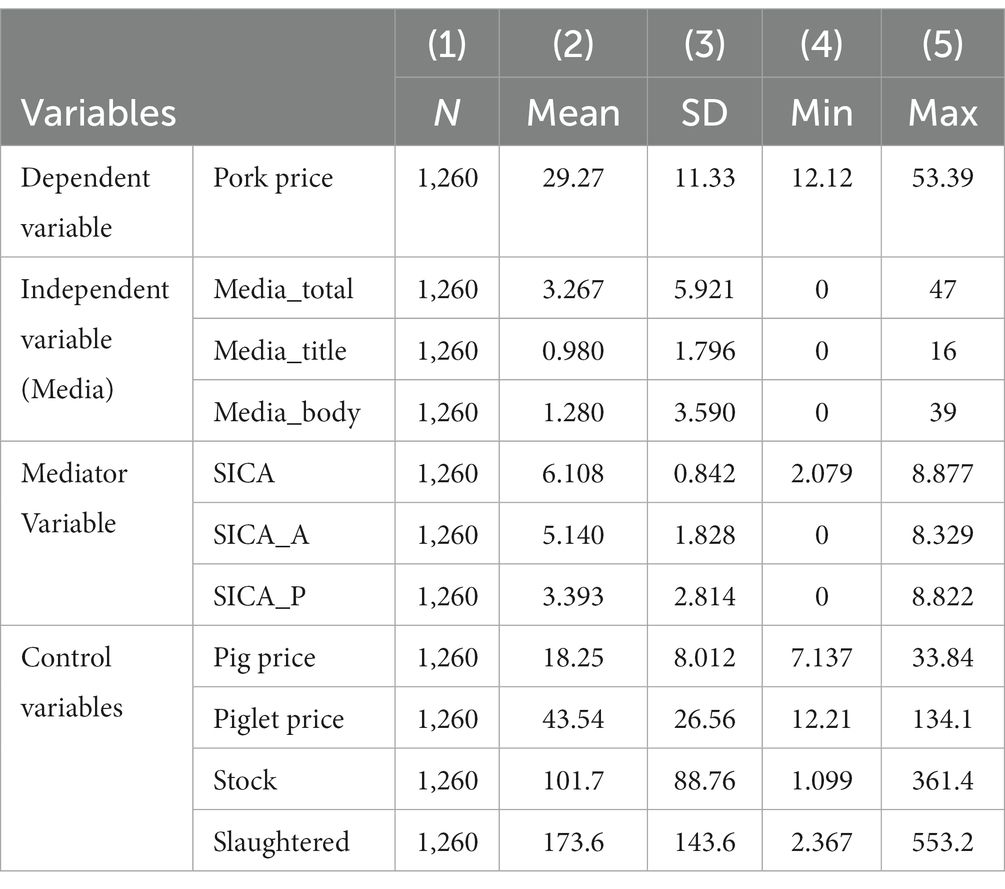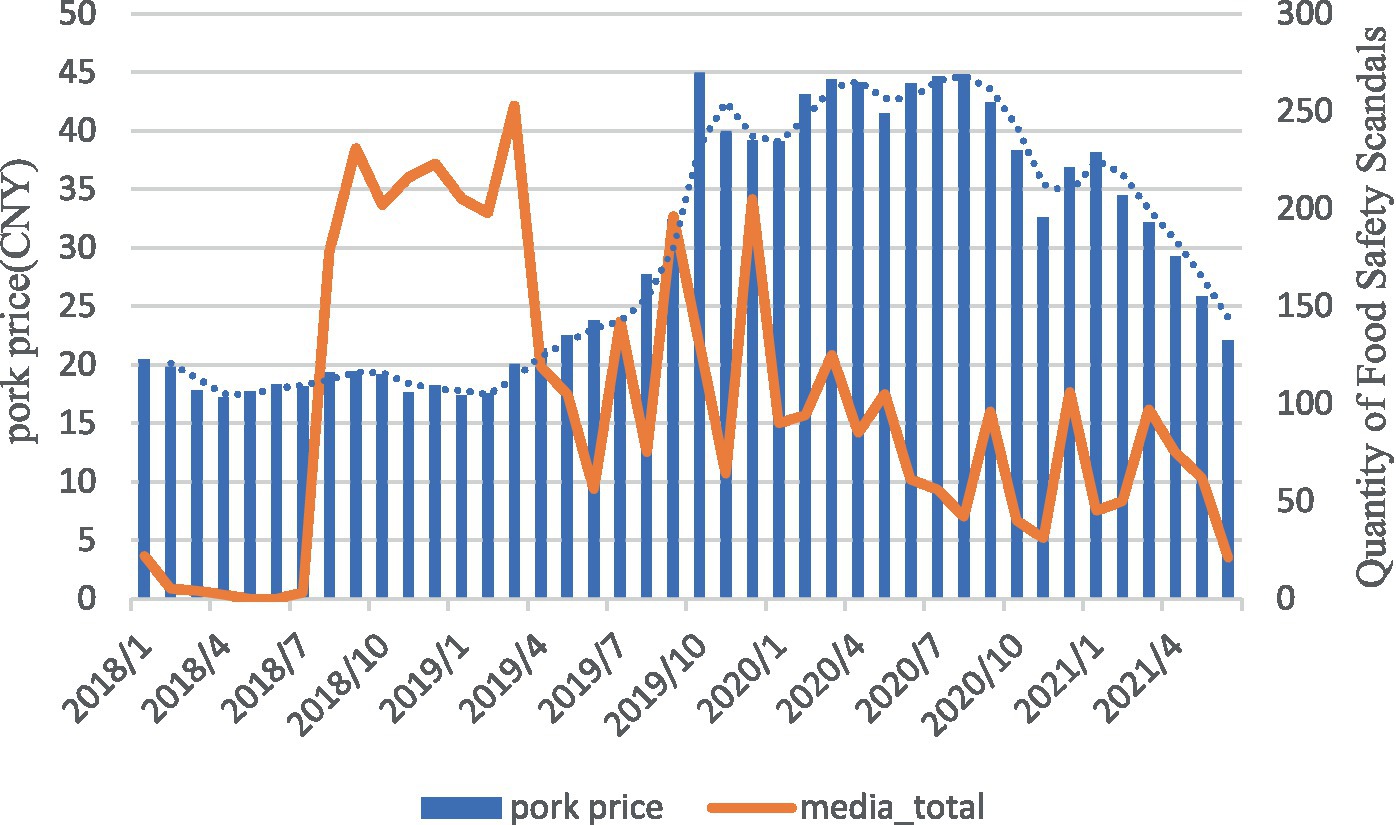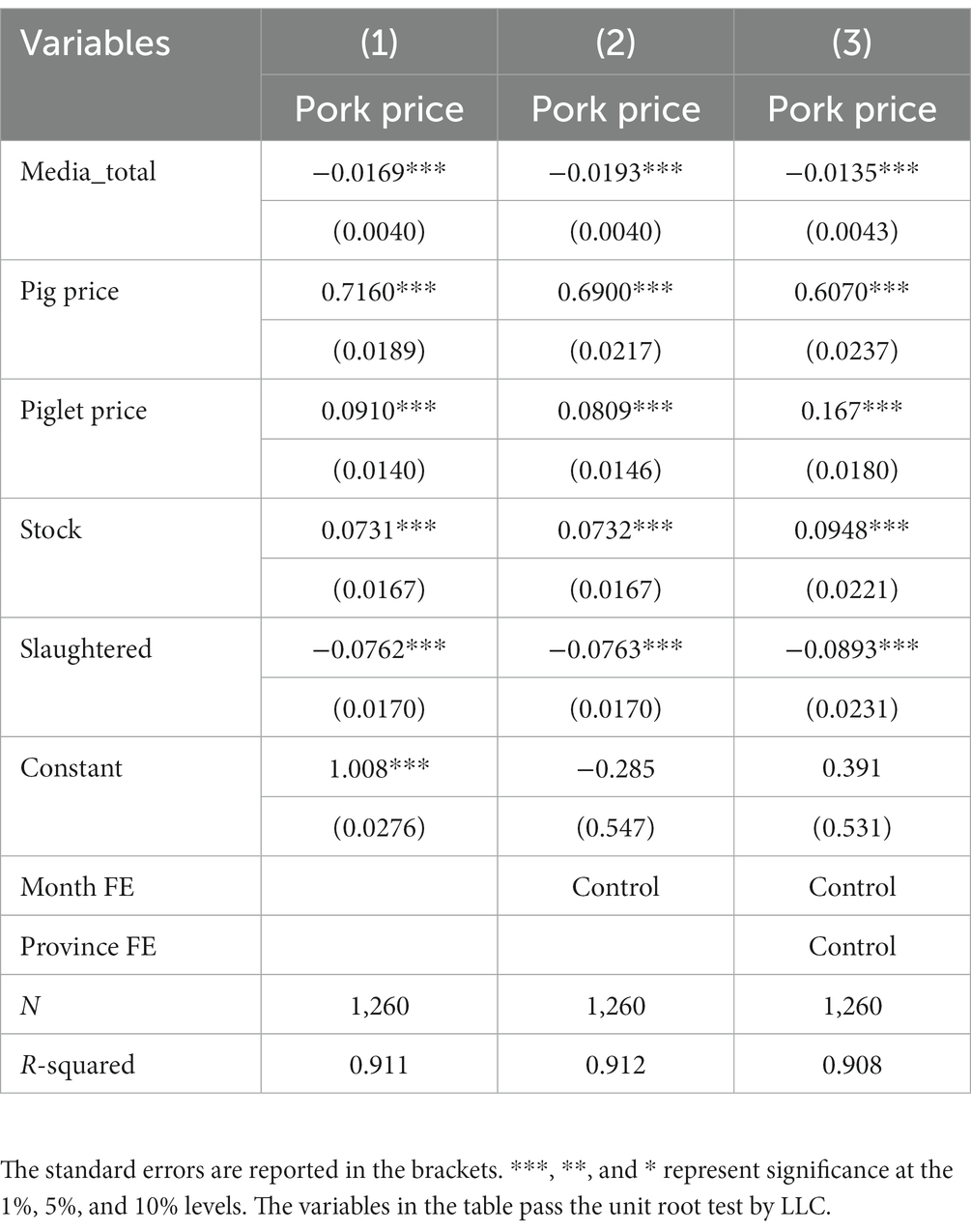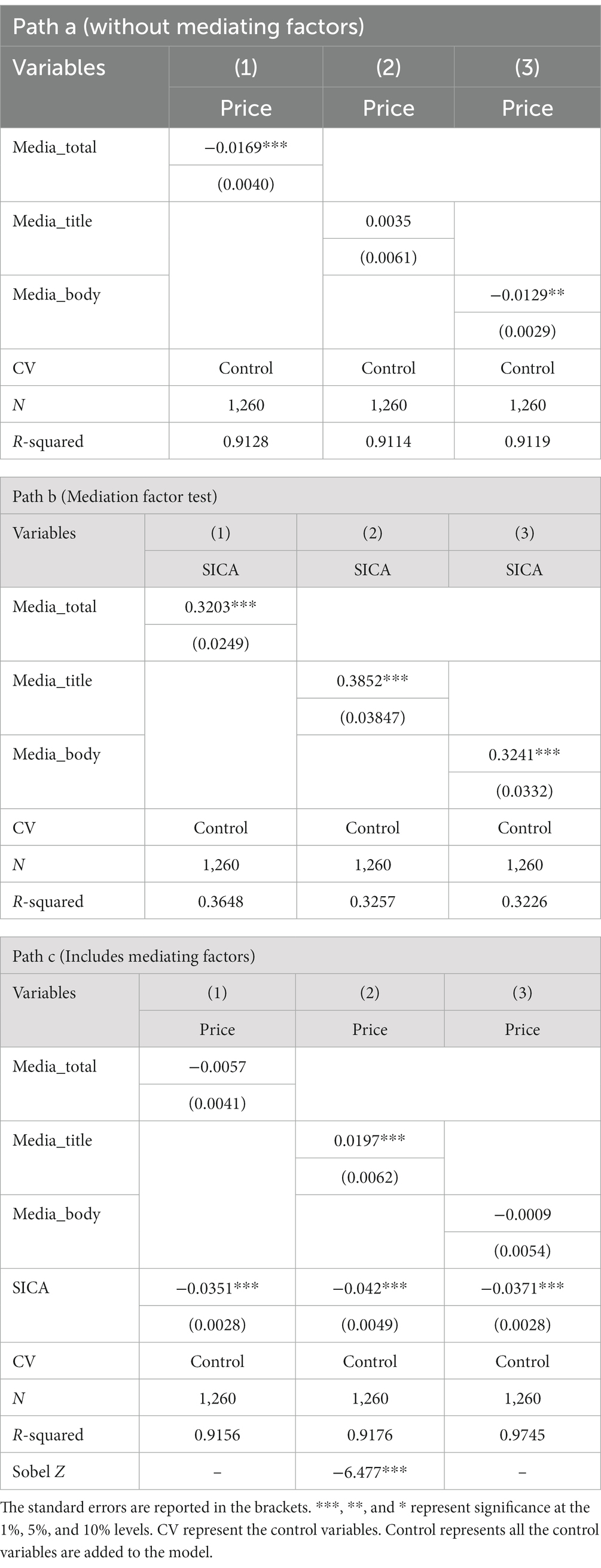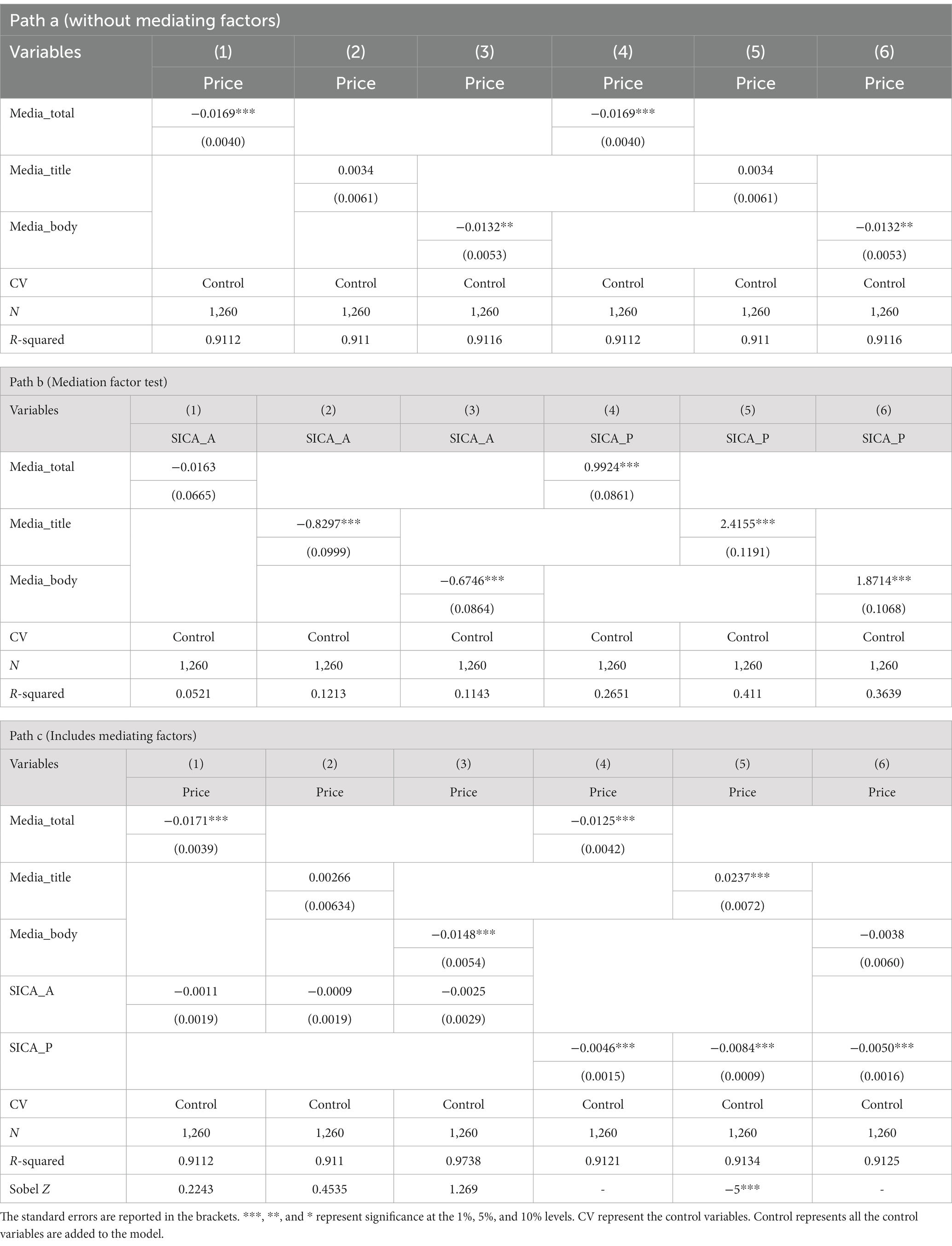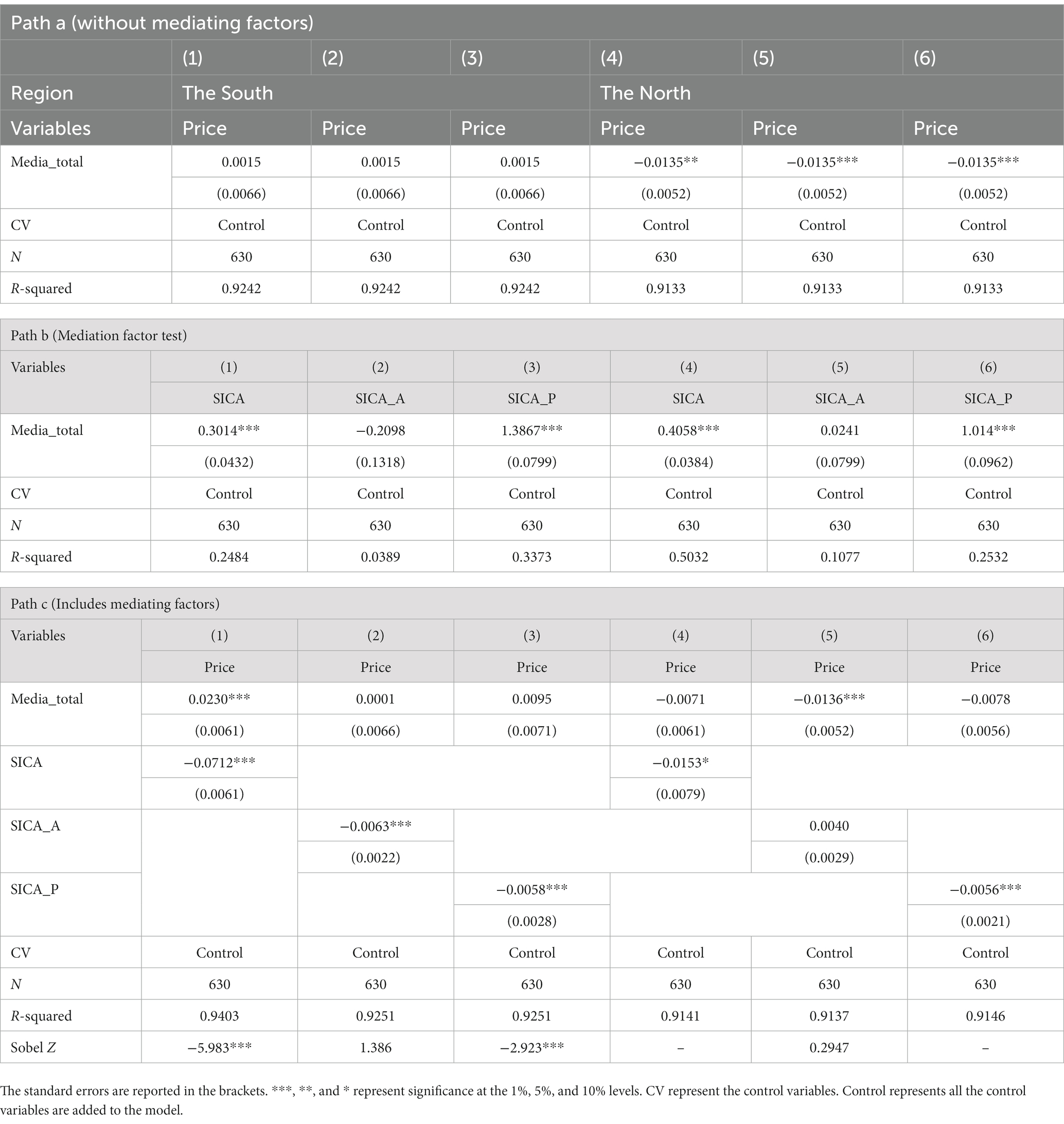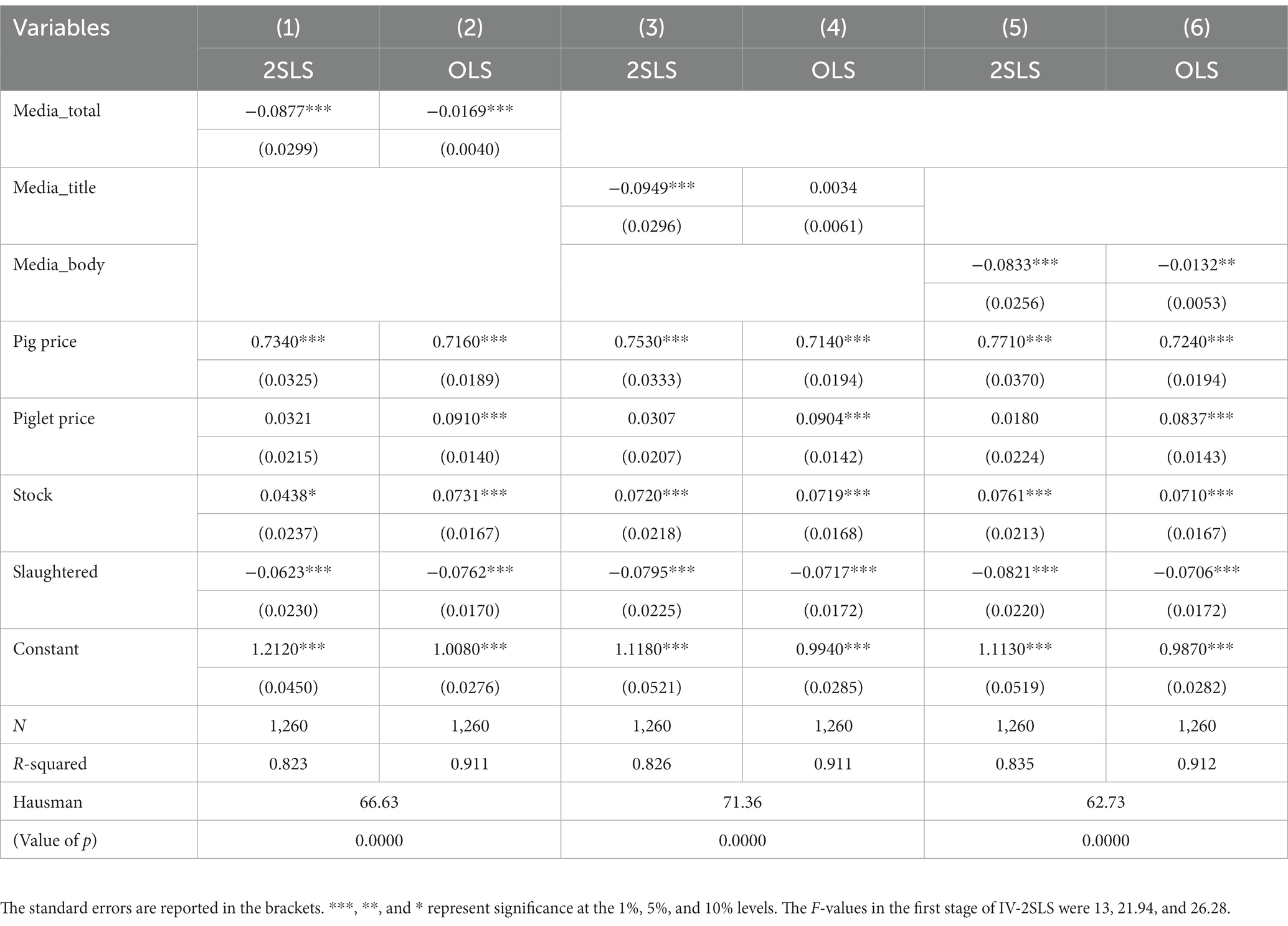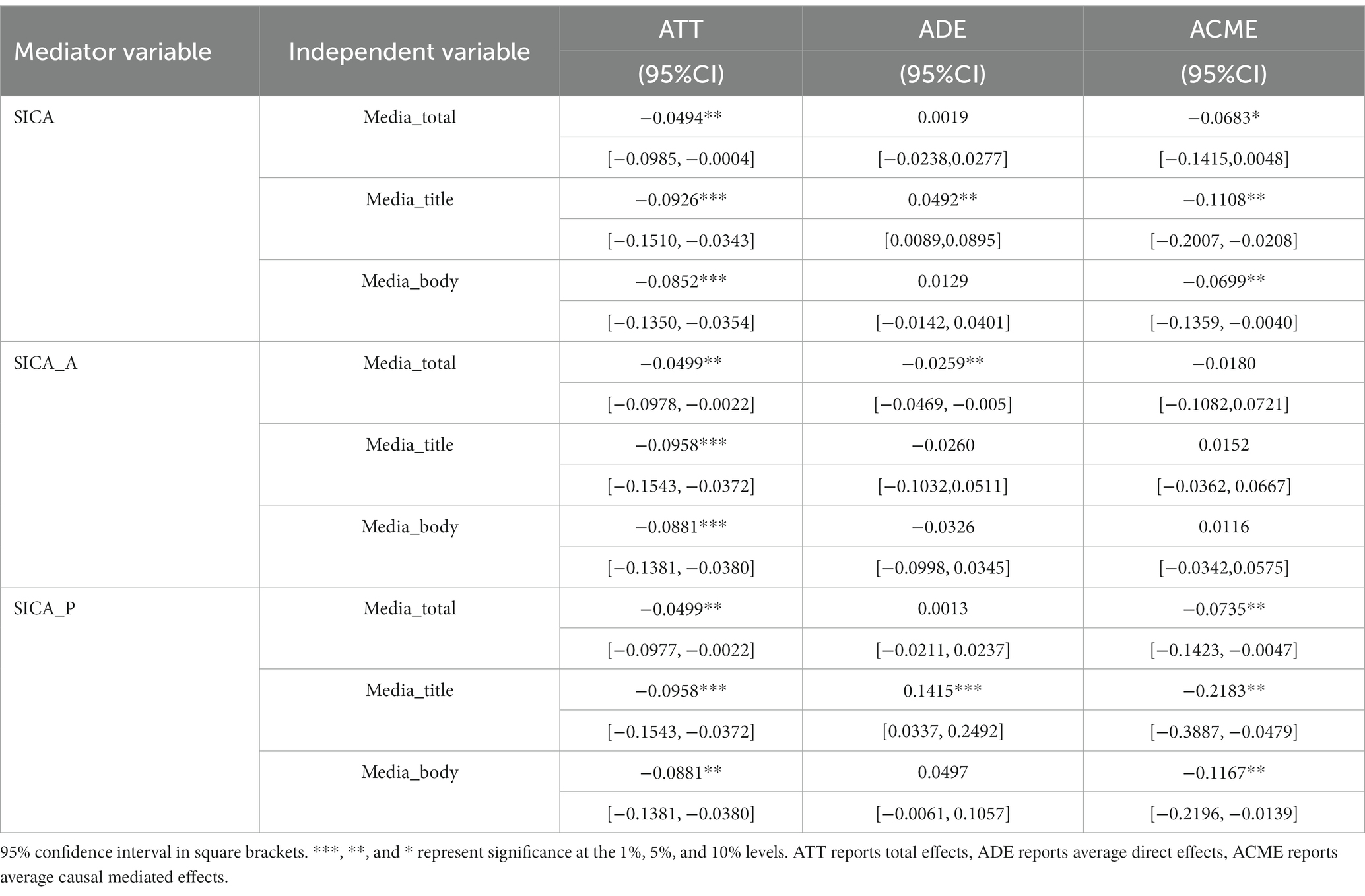The impact of food safety scandals on pork prices from consumer concern perspective: evidence from China
- College of Economics and Management, Huazhong Agricultural University, Wuhan, China
In the era of fast communication, consumer attention is a hidden demand signal that cannot be ignored. This study investigates the impacts of media coverages on pork prices from the perspective of consumer concerns. We employ monthly panel data spanning from January 2018 to June 2021 at the provincial level. Specifically, the study investigates the mediating role of consumer attention, which is categorized into “active attention” and “passive attention,” in the relationship between food scandal report and pork prices. The empirical results suggest a negative short-term correlation between food scandals coverages and pork prices, and reveal that passive-guided consumer attention plays a more significant mediating role than active attention in this relationship. Furthermore, a heterogeneity analysis based on the North–South partition indicates that the mediating transmission effect of consumer attention is more pronounced in regions with relatively stable supply. Overall, this study contributes to the existing theoretical literature on the impact of media coverages on agricultural prices, and provides practical implications for the government to regulate media coverages, and guide consumers to respond appropriately to food safety risks.
1. Introduction
The co-occurrence of animal diseases and food safety incidents is a common phenomenon. In China, the outbreak of African swine fever in August 2018 led to the detection of quality and safety problems in several large pork suppliers, resulting in a decline in consumer confidence and widespread food safety panic. The increasing importance of news media coverages in economic activities has received considerable attention from scholars. In recent years, the impacts of media coverages on agricultural markets, especially on the demand and price of agricultural products have been a prevailing topic in existing literature (Zeng et al., 2019). With the rise of self-media, online media has become the primary channel for public information. The food safety scandals are mostly reported through online news reports. However, the abundance of information available online has made public attention a scarce resource. Online media tend to use negative bias and exaggeration to attract attention (Gentzkow and Shapiro, 2006) as consumers are more sensitive to negative information (Soroka, 2006). This leads to biased public perceptions of food safety risks, reduced purchasing behavior, mass panic (Yu and Bai, 2023) and price oscillations in local and even the entire market, with a greater negative impact on the industry’s upstream supply chain and even the entire market (Wen et al., 2020).
Animal diseases and veterinary drug residues are the two major factors causing quality and safety problems in pork products, and quality and safety problems in livestock and poultry are often highly correlated with animal diseases. Previous studies have focused on the impact of “mad cow disease” on the beef market (Serra, 2011; Houser and Karali, 2020) and “avian influenza” in domestic studies (Ding et al., 2019; Liu et al., 2021). However, public confidence in food safety is greatly diminished even when animal outbreaks are not “contagious” to humans. Most scholars study the impacts of African swine fever on agricultural markets from a supply deficit perspective. Fewer scholars focus on the impact of food safety scandals and consumer panic on the market from a demand market perspective. This study seeks to fill this research gap by examining the impact and mechanism of action of food scandal report on pork prices from the perspective of consumer concern.
Frequent negative information about food scandal report leads to panic and exclusionary psychology among highly risk-averse consumers, resulting in excessive risk prevention behavior, reduced pork consumption demand, or a shift in consumption demand to other meats. Individual panic can easily cross-infect, leading to group convergence behavior, which in turn affects the demand of the pork market. Attention reflects the interaction relationship between media reports and consumers, portraying the degree of public attention to media reports and the amount of influence media reports have on public behavior. Consumers who pay more attention to events are more susceptible to the contagion of media emotions (Wu and Yao, 2022). Therefore, this study focuses on whether consumer attention can play a mediating role in the path of food scandal report on pork prices.
To investigate the mediating role of consumer concern, this study uses monthly provincial panel data from 2018.1 to 2021.6. The study categorizes consumer concern into “active spontaneous concern,” which is spontaneous concern about pork safety issues, and “passive guided concern,” which is guided by media reports to pay attention to pork safety issues. The empirical results show that consumer concern plays a mediating role in the impact of food scandal report on pork prices. Further analysis reveals that active spontaneous concern has no mediating effect, and passive-guided concern is the primary factor in the mediating effect of consumer concern. Finally, regional heterogeneity analysis concludes that the mediating effect of consumer concern accounts for a larger proportion of the total effect in cases of stable supply, and the impact of food scandal report on pork prices is more pronounced.
The academic contributions of this study include providing an entry point perspective by examining the impact and mechanism of action of food scandal report on pork prices from the perspective of consumer concern, revealing the difference in the transmission role of active spontaneous concern and passive guided concern, and considering the geographical characteristics of China’s pork industry layout to test the heterogeneity of north–south regions under the special background of African swine fever. Furthermore, this study employs IV-causal mediated effect estimation to overcome possible two-way causality problems in the model, which enhances the research results’ reliability.
2. Theoretical framework
In the context of African swine fever, food safety issues have garnered increased attention from the media and consumers. The analysis of the impact of food scandal report on pork prices is primarily based on two theoretical logics.
From the perspective of information economics, it is argued that the widespread use of the Internet has improved the efficiency of market information and the quality of information disclosures. The decision-making process of economic agents is influenced by their cognitive processing of information Online media has become the primary channel for consumers to obtain information, and their dependence on online media reports has increased. Consumer preferences for meat products are influenced by the information available to them, and negative information has a greater impact on price fluctuations of agricultural products than positive information. Under the influence of negative information, consumers tend to reduce their demand for the product out of interest to avoid harm, even when faced with false news.
The shift from a seller’s market to a buyer’s market in the Internet economy has given consumer demand decisions a stronger influence on product prices. Food safety scandals can decrease consumer demand for agricultural products. For instance, “mad cow disease” led to a decrease in consumer demand for beef (Verbeke, 2001). Food safety reports not only affect the market price of the current product, but also affect the market price of other products in the industry chain (Attavanich et al., 2011). As pork and beef are mainly consumer meat products with similar production characteristics. The impact of food safety scandal report is likely to reduce consumers pork purchasing behavior, consumption, and affecting the market price of pork.
From the perspective of mass communication, Noelle-Neumann (1974) proposed the spiral of silence theory, which suggests that people who disagree with the dominant view in the media remain silent for fear of being ostracized. The “spiral of silence” effect still exists in cyberspace (Kushin et al., 2019), making it difficult to change the opinion once it has gained an advantage (Ross et al., 2019).
In the era of fast communication, it provides a basis for risk amplification of agricultural quality and safety events (Zhang et al., 2021). High-impact online media often act as “opinion leaders” and have a greater influence on information recipients in emergencies (An et al., 2020). Consumers are more concerned about negative information when it comes to food safety. Negative information tends to dominate public opinion more easily than comprehensive information, while having a greater impact on consumer behavior (Boukes et al., 2021).
Animal disease outbreaks are often accompanied by food safety incidents. When quality and safety scandals involving pork come to light, some consumers shift their consumption demand for pork to other meats as a result of their risk-averse instincts. Another group of consumers susceptible to media contagion will instinctively panic and reject, engage in excessive risk-averse behavior, and reduce pork consumption demand. Individual panic is easily contagious, leading to group convergence behavior, which affects the overall market demand. Media coverages have a greater impact on meat product price fluctuations than other categories of agricultural products due to the high elasticity of meat product demand (Zeng et al., 2019). Based on this, we formulate the following hypothesis.
H1. The occurrence of pork quality and safety incidents can lead to a decline in pork prices, and in the short term, the number of reported food scandal reports is negatively correlated with pork prices.
With the development of information technology, the attention of economic agents to obtain information has become a scarce resource (Simon, 1955). Attention is a limited resource (Sims, 2006). The allocation of attention determines the capacity and structure of an economic agent’s information pool, which in turn affects their economic decisions. As media coverages of food safety events increase, a short period of time will attract a high degree of consumer attention. The changes in the configuration of consumer’s attention affect their purchasing decisions.
Food quality information has the property of an “empirical product,” which is often difficult to be recognized for consumers (Zhou et al., 2022). It is not the real food safety risk, but the subjective risk perception that influences the individual’s food safety evaluation and decision-making behavior (Tian and Liu, 2021). The essence of media coverage is information transfer. The impact of food safety coverages on product prices depends largely on the impact of the coverages on consumers, and the magnitude of this impact depends on the allocation of consumer attention to the food safety event. Consumer attention is a good measure of the allocation of consumer attention to events (Da et al., 2011) Consumers who pay more attention to the events are more likely to be infected by the emotions of the media. Due to the characteristics of agricultural products, it is more difficult for consumers to obtain food quality and safety information, and they have a strong dependence on the online media reports. The influence of media reports on the purchasing behavior of consumers is enhanced. Therefore, in the path of food safety scandal’s reports affecting pork market price, consumers’ online attention is a mediating variable that cannot be ignored. We formulate the following hypothesis on this basis.
H2. Consumer concerns mediate the impact of food scandal report on pork prices.
Reports of food safety incidents can cause consumer food safety panic and increase consumers’ perceived level of risk. The higher the perceived level of risk, the higher the level of consumer information seeking (Yang et al., 2021), and the more attention paid to food safety incidents. The mechanism of media coverages on price is essentially a change in consumer purchasing behavior caused by the information transfer process. This influence path may not hold if there is no audience or if the audience is indifferent.
The influence of media coverages on consumers is related to the risk perception status of consumers. Consumers with a high-risk perception status are more likely to be emotionally charged by media reports and overreact. Consumers with a low-risk perception status are less likely to be infected by media reports. Information seeking is an effective means of reducing the risk-perception of uncertainty (Liu and Wu, 2013). Consumers’ information-seeking behavior directly affects their perception of food safety risks. Consumers’ motivation to seek information is a good indicator of their risk prevention attitudes. Active and spontaneous concern is a measure of the level of concern of consumers who have better mechanisms for preventing food safety risks and who are less likely to be infected by the emotions of media reports because they are well-informed about the relevant information. Passive-guided concern rather represents the degree of attention to quality and safety events of consumers who lack risk prevention mechanisms for food safety risks, and such consumers are more likely to be in a high-risk perception state infected by the emotions of media reports and to overreact and other behaviors when unexpected events occur. Based on this, the third research hypothesis of this paper is proposed.
H3. The mediating effect is only present for passive-guided consumer attention, whereas the mediating effect is not present for active self-initiated consumer attention.
3. Sample and empirical strategy
3.1. Data and sample description
3.1.1. Media coverage
This paper uses Python software to crawl pork quality and safety-related news. Since the main body of pork quality and safety scandal is mostly released by government departments at all levels (Zhou et al., 2016), this paper selects the official media with independent news gathering and editing rights of People’s Daily Online and Xinhua Daily Online for data mining, which not only release news information by themselves, but also reprint the news reports of other online media and paper media, and at the same time, they will be reprinted by other media as well. Specific steps are as follows: first, determine the keywords, pesticide and veterinary drug residue exceeds the standard leading to agricultural food safety major factors (Xu and Pang, 2015), pork quality and safety problems are mainly concentrated in two significant aspects of animal disease and veterinary drug residues. Therefore, “swine fever” “diseased pork” and “lean meat powder”1 were used as keywords to search for relevant news published from January 2018 to June 2021. By limiting the domain names of People’s Daily and Xinhua Net, using the Baidu search engine as a search tool, relevant reports were crawled according to the keywords, and 6,210 news reports were obtained after deleting irrelevant and repeated reports. At the same time, the samples are extracted into three sample groups: total number of reports (Media_total), reports with keywords in the title (Media_title), and reports with keywords in the content (Media_body). The data are categorized into provincial panel data based on where the coverage occurred.
3.1.2. Search index of consumer attention (SICA)
With the rapid development of social networks, the changes in group search behavior on the Internet and the browsing index of microblogs, forums, and other social media directly reflect the group’s attention to the event. They can more directly reflect the group’s attention and emotions (Shi et al., 2017). In the Internet era, big data is a vast and diversified data set, and consumer search behavior is an objective expression of consumer attention to events. It can dynamically respond to consumer attention (Xu and Wu, 2020). Compared with the foreign Google Trends Index, scholars in China usually use the Baidu search index as a proxy variable for consumer attention, and this paper adopts the weekly sum of the Baidu search index to calculate the monthly attention of consumers.
Meanwhile, this paper categorizes consumer attention into active and passive types according to Wang et al. (2021). Active-spontaneous attention (SICA_A) is defined as the region that has not been reported by the media on food safety issues within the week before the consumer search on the topic of pork safety. Consumers’ attention to the event is an active type of attention that is not influenced by media reports; passive-guided attention (SICA_P) is defined as the area has been covered by the media for food safety news within the week prior to the consumer’s search for food safety information. Consumer concern about pork food safety in this location is a passive concern induced by the influence of news media reports.
The specific measurement methods of active, spontaneous concern and passive guided concern are as follows: First, the Baidu search index (weekly) data are divided into two groups according to whether there is a report on pork quality and safety-related topics in the previous week’s; if there is a relevant report in week t-1, the Baidu search index in week t is counted in the passive concern group, and vice versa in the active concern group. Second, taking month as the statistical caliber, weekly data are extracted, and the two groups are accumulated to obtain the active spontaneous attention index SICA_A and the passive guided attention index SICA_P for month t in region i. Finally, t-tests and z-tests are performed on the two groups of indices to enhance the reliability of the design of the two indices.
3.1.3. Control variables
This paper selects the following control variables concerning the existing literature on the influence of pork price changes. (1) Farming cost level. The input cost generated in the process of pig breeding is the main factor affecting the price change of pork; piglet cost is the primary index to measure the cost of pig breeding (Zhang et al., 2018); this paper takes piglet price as the control variable at the breeding level. (2) Industry chain adjustment level. In the pork market, the price transfer between industry chains is an essential factor leading to pork price changes, and there is a synergy between the price of pigs and the price changes of pork, so the pig price is chosen as the control variable to measure the changes in the industry chain. (3) Supply level. The number of hogs in the herd (Stock) and the number of hogs slaughtered (Slaughtered) are representative indicators of the pork supply, which affects the pork price through the supply level. All the price data in this paper are from China Animal Husbandry Information Network (CAIN), and the data on slaughtered and stocked pigs are from China Animal Husbandry Yearbook (CAY). Sample data processing, regression analysis, and Sobel’s test for mediation effects were performed using STATA 15.0.
Table 1 reports descriptive statistics for the variables used in the empirical analysis. Note that the sample size N here represents the number of sections of provincial panel data. Each section has data from one of the 30 provinces (excluding the Tibet Autonomous Region) and one of the 32 months, forming panel data consisting of 1,260 sections. The standard deviation of passive-guided attention (SICA_P) is three times higher than that of consumer attention (SICA) and 1.5 times higher than that of active spontaneous attention (SICA_A). Passive-guided attention has a higher variability than active consumer attention. Changes in passive-guided attention caused by food safety scandal reports may be a mediating factor that further influences pork price changes, provisionally validating research hypothesis 3.
Figure 1 displays pork prices and media coverage from 2018 to 2021 Pork price data are seasonally adjusted series using the X12--ARIMA method in EViews. The trend in “Media_total” shows that the period of high negative media coverages coincided with the outbreak of African swine fever in China. During that period, the food safety scandal’s coverages remained high and pork prices exhibited a slight downward trend. Pork prices rose sharply in September 2019 due to insufficient supply. Some small bands of pork prices do not show opposite trends to the overall media coverage trend. However, the trend of “Media_total” and pork prices show the opposite. The time series data do not explain the phenomenon of opposite trends between the two in some of the bands. Therefore, panel data was chosen in this paper.
3.2. Empirical strategy
To test the underlying relationship between food scandal report and pork prices, the Baseline model in this paper is as follows.
Suppose the coefficient of the explanatory variable Media in the model is significant and positive. In this case, it indicates a positive correlation between food scandal coverages and pork prices, while the opposite is true for a negative correlation.
In order to examine whether consumer concern functions as a mediating variable in the relationship between food scandal report and pork prices, we used the Sobel mediation effect test improved by Wen et al. (2004). The following three-path models are adopted to test the mediation effect of consumer concern in the path of food scandal report on pork prices.
In the empirical analysis, all economic data are price deflated using the consumer price index, and all variables are treated logarithmically to eliminate the effect of heteroskedasticity. The indicates that all the control variables mentioned in Table 1 are added to the model. . The mediating effect of consumer attention on SICA is tested through the above three-path test model. A full mediation effect is assumed if both coefficients c and a are significant, but coefficient c’ is insignificant and b is significant. If both coefficients c and a are significant, and both coefficients c’ and b are also significant, then a partial mediation effect is judged to exist. However, because the sign of the indirect effect ab may be opposite to the sign of the direct effect c’, making the overall effect c insignificant, the mediation effect is still present (Zhao et al., 2010). If at least one of a and b is not significant, a Sobel test is required, and if the value of Sobel Z is significant, there is a partial mediating effect. Otherwise, there is no mediating effect. Similarly, two consumer attention indices, SICA_A and SICA_P, are used as mediators in the path test model above to test the mediating effect of active-spontaneous, and passive-guided attention.
4. Empirical results and discussion
4.1. Effect of food scandal report on pork price
Table 2 presents the results of the baseline model. Columns (1)–(3) represent results from least squares dummy variable (LSDV) models. Specifically, the table reports the estimation outcomes of the baseline model without province fixed effects and monthly fixed effects (Columns 1). The model accounting for monthly fixed effects (Column 2), and the model accounting for both province fixed effect and monthly fixed effect temporal (Column 3). The regression coefficients for the variable measuring the total number of reports on pork quality and safety (Media_total) are all negative and statistically significant at the 1% level, ranging from-0.0193 to-0.0135, indicating a negative association between food scandal report and pork prices. An increase in food scandal reports is found to lead to a decline in pork prices. Among the control variables, both pig price and piglet price (exhibit significant positive effects at the 1% level, suggesting a strong linkage between the prices of pig and piglet and those of pork. The variable measuring pig stock is positively significant at the 1% level, while pig slaughtered is negatively significant at the 1% level, indicating that pig slaughtered is a more representative control variable of actual pork supply. In columns (1)–(3), the value and significance of the variables’ coefficients are not significant differences. The results indicate that pork prices were less affected by the inherent differences between provinces and the inherent month differences.
4.2. Analysis of the mediating effect of consumer attention
Columns (1)–(3) of Table 3 show, in order, the results of the mediation factor “SICA” for the three paths of the mediation effect of Path a, Path b, and Path c in the total sample, the title keyword sample group, and the content keyword sample group. Specifically, Column (1) reveals that the regression coefficient of the variable measuring the total amount of media coverages on pork quality and safety, Media_total, is significantly negative at the 1% level in path a. In path b, the coefficient of Media_total is positive and significant at the 1% level, signifying that an increase in the total number of reports on pork quality and safety leads to a rise in consumer attention to the event. In path c, after the mediating factor (SICA) is added to the model, the coefficient of Media_total becomes smaller and insignificant, while the coefficient of SICA is significantly negative at the 1% level, demonstrating a fully mediated effect of consumer attention on the relationship between media coverages and pork prices. The regression results of the two subgroups exhibit similar patterns to those of the full sample, with consistent statistical significance.
In Column (2) of the table, the regression coefficient of the variable measuring the presence of keywords in the title of media coverages, Media_title, is found to be statistically insignificant in path a. In path b, however, the coefficient of Media_title is positive and significant at the 1% level. After adding the mediating factor SICA in path c, the coefficient of SICA is estimated to be-0.42, significant at the 1% level, while the regression coefficient of Media_title is 0.0197, also significant at the 1% level. The Z-value of Sobel’s test is greater than the critical value of 2.58 in absolute value, indicating a mediating effect. Unexpectedly, the sign of the variable Media_title is not as expected after the mediator is added, but consumer attention is still negatively correlated with pork prices. This may be because while “headline news” can increase consumer attention to the event, the number and volatility of such news in the official media are relatively stable due to their strong leading effect. Meanwhile, the African swine fever outbreak has created a large supply gap and a sharp increase in pork prices, creating the illusion that headline news and pork prices move in the same direction. In Column (3), the indirect effect produced by adding the mediating factor SICA is in the same direction as the direct effect, and the regression results confirm a fully mediated effect of consumer attention. The empirical outcomes of both the full sample and subgroups support the existence of a mediated effect of consumer attention in the relationship between media coverages and pork prices, thus providing evidence for Hypothesis 2 of this study.
4.3. Comparison of mediation effect tests for passive-guided versus active-spontaneous attention
This study differs from previous research by examining the mediating effects of two types of attention, namely active spontaneous attention (SICA_A) and passive guided attention (SICA_P), on the relationship between media coverages and pork prices. Table 4 presents the results of the mediation effect tests, with columns (1)–(3) reporting the outcomes of the analysis where the mediator is SICA_A, and columns (4)–(6) presenting the outcomes of the analysis where the mediator is SICA_P. In path b, both active spontaneous attention and media reports are found to exhibit negative correlations, while passive guided attention and media reports demonstrate positive correlations. The empirical results suggest that consumers who possess an active interest in pork quality and safety events are unlikely to increase their attention in response to a sudden surge in media coverages, and may even become disinterested in the abundance of news reports, leading to a decrease in their attention to the event. On the other hand, consumers who lack a coping system for food safety risk prevention are more susceptible to an increase in their attention to pork safety events in the presence of quality and safety scandals.
In columns (1)–(3), none of the coefficients of the mediating factor SICA_A is significant and the Z-value after Sobel’s test is not significant. Therefore, there is no mediating effect of active spontaneous consumer concern in the path of food scandal report on pork prices. In column (4), in path a, the regression coefficient of Media_total is significant and negative, in path b, the regression coefficient of Media_total is significant and positive, and in path c, the regression coefficients of the variable Media_total and the variable SICA_P are significant and negative, indicating that there is a partial mediating effect of SICA_P. In column (5), the regression coefficients of Media_title in path a are insignificant, in path b, the regression coefficients of Media_title are significant and positive, and in path c, the regression coefficients of the Media_title and the SICA_P are significant, and the corresponding Z-value of Sobel’s test is greater than 2.58, suggesting that there is a partial mediating effect of SICA_P. In column (6), in path a, the regression coefficient of Media_body is significant and negative, in path b, the regression coefficient of Media_body is significant and positive, and in path c, the regression coefficient of Media_body is insignificant and the regression coefficient of SICA_P is significant and negative, suggesting that there is a fully mediated effect of SICA_P. The empirical results show that passive-guided consumer attention has a mediating effect in the effect of food safety reports on pork prices, while active-spontaneous consumer attention does not have a mediating effect, validating Hypothesis 3 of this paper.
4.4. Heterogeneity across geographic regions
China’s pork industry has exhibited the production characteristics of “raising southern pork in the north,” which has resulted in significant differences between the supply and demand structures of the northern and southern regions. In addition, the African swine fever epidemic prevention and control policy has imposed restrictions on inter-regional hog transportation, exacerbating the regional disparities in the industry. To investigate potential heterogeneity in the mediating role of consumer concerns between the North and the South, this study conducts a comparative analysis across geographic areas, i.e., the South and the North.
Table 5 presents the results of the heterogeneity analysis based on the North–South division. Columns (1)–(3) report the outcomes of the sequential mediation effect tests of the three mediators, namely SICA, SICA_A, and SICA_P, for the southern region, while columns (4)–(6) present the corresponding results for the northern region. In columns (1) and (3), both the mediator SICA and the mediator SICA_P exhibit mediating effects, as evidenced by the significant regression coefficients of media in path b and the Sobel test passing in path c. This suggests a significant mediating effect of consumer attention and passive-guided attention on the relationship between food safety reporting and pork prices in the southern region. In columns (4) and (6), the regression coefficients of media in path a and b are significant for both the mediator SICA and the mediator SICA_P, while path c demonstrates a complete mediation effect of SICA and passive-guided attention on the impact of food safety reports on pork prices in the northern region. Furthermore, in columns (2) and (5), the mediator SICA_A fails to pass the Sobel test, indicating that the active spontaneous attention of consumers does not play a mediating role. Further analysis reveals that the effect of news media coverages on prices is generally insignificant in the southern region, while in the northern region, it is significantly negative in PATH A. In PATH C, both the SICA and SICA_P mediation effect tests show full mediation effects in the northern region, while they demonstrate partial mediation effects in the southern sample. This suggests that under stable supply, consumer concern regarding pork safety events represents an implicit demand, and the effect of news media reports on pork prices is transmitted to a greater extent through consumer concern.
5. Robustness check
5.1. Addressing endogeneity
The existence of a “two-way causality problem” between media coverages and pork prices raises concerns regarding endogeneity. Specifically, higher pork prices may affect the media’s interest in covering pork-related topics. To address this issue, we follow Wang et al. (2021) and use TopicH as an instrumental variable for media coverages. TopicH refers to the degree of public awareness of food safety events, which is highly correlated with the number of pork quality and safety scandals. However, TopicH does not directly affect pork prices and only indirectly affects them through media effects. The use of instrumental variables is appropriate in this case as TopicH satisfies the condition that it cannot directly affect the explanatory variables but can affect them through the explanatory variables. We measure TopicH by searching the noisy “region + keywords” on the Baidu search engine and obtaining the number of relevant web pages retrieved by Baidu, n, and then using the natural logarithm of n to measure the food safety topic’s hotness.
We employ the two-stage least squares (IV-2SLS) regression method to estimate the impact of media coverages on pork prices using TopicH as the instrumental variable. We compare the results of the IV-2SLS regression with those of the original baseline regression (OLS) using the Hausman test, as shown in Table 6. Columns (1)–(6) display the comparison between the empirical results of IV-2SLS regression and OLS regression when the core explanatory variables are Media_total, Media_title, and Media_body, respectively. The Hausman test values for the three sets of regressions are 66.63, 71.36, and 62.73, respectively, with value of ps of 0, all of which reject the initial hypothesis that there is no significant difference between the results of the IV-2SLS regressions and the OLS regressions. These results suggest that the application of instrumental variables effectively mitigates the endogeneity of the model, and the regression results using 2SLS are more credible. The IV-2SLS regression with the core explanatory variable Media_title compared to the OLS regression shows that after mitigating the endogeneity problem of the model, the coefficient of the core explanatory variable is negative and significant at a 1% confidence level, indicating that an increase in the number of stories with food safety issues in the headlines leads to a decrease in the price of pork. The results of the instrumental variables approach are consistent with the results of the benchmark regression, supporting the research hypothesis presented in this paper.
5.2. Robustness test based on IV causal mediation analysis method
Using the causal mediated effects estimation method developed by Pinto et al. (2019), this paper uses instrumental variables (TopicH) to verify that the research hypotheses still hold after mitigating the model endogeneity problem. Table 7 presents the results of the IV causal mediated effects model regression, which reports the total, average direct, and average causal mediated effects for the full sample and subsample regressions that correspond to the mediating variables SICA, SICA_A, and SICA_P, respectively.
The estimation results reveal that when the mediating variable is SICA, the average causal mediation effect (ACME) of total news media coverages on pork prices through consumer attention is −0.0683, and its corresponding 95% confidence interval excludes 0, indicating the presence of a significant mediation effect. In the subsample regression, where the explanatory variables are replaced by Media_title and Media_body, the mediation effect of the variable SICA remains significant. Conversely, when the mediating variable is SICA_A, the ACME of total news media coverages affecting pork prices through active self-directed attention to SICA_A is-0.018, and its corresponding 95% confidence interval includes 0, indicating that the estimated value of the ACME is not significantly different from 0 at the 5% significance level. The results of the subsample regressions are consistent with those of the full sample regressions, both indicating the absence of a mediating effect of active self-directed attention in the path between news coverages and pork prices. However, when the mediating variable is SICA_P, the ACME for total news media coverages affecting pork prices through passive-guided consumer attention is-0.0735, and its corresponding 95% confidence interval excludes 0, indicating the existence of a significant mediating effect. The estimation results for both the total sample and subsample indicate a negative total effect of news media coverages on pork prices, with a significantly negative ACME. Furthermore, the ACME values of passively guided concern (SICA_P) are higher than those of consumer concern (SICA), suggesting that consumer concern generated after being influenced by media reports has a greater impact on pork prices. Consumers are susceptible to the emotional impact of media reports, leading to an increase in the avoidance of food safety risks and a reduction in the effective demand for pork, resulting in a decrease in pork prices.
6. Conclusion
This study examines the impact of food scandal report on pork prices, focusing on the role of consumer concern. The main findings are as follows: Firstly, food scandal report can affect pork price trends by triggering consumer concerns about quality and safety issues. Secondly, passive-guided concerns induced by media reports serve as a mediating mechanism through which pork quality and safety affect product prices; active-spontaneous concerns do not play a mediating role in this path. This finding underscores the importance of media emotions in shaping consumer attention and highlights the differences in consumers’ attention motives. Thirdly, heterogeneity analysis of the North–South divide reveals that the effect of food scandal report on product prices is more pronounced in regions with relatively abundant supply security, where consumer attention mediates the relationship between scandals and prices more significantly. This study contributes to the existing literature on the impact of online media coverages on agricultural prices by demonstrating that even in the absence of human transmission events such as epidemics, reports of agricultural product quality and safety are still negatively associated with agricultural product prices, and the strength of this relationship depends on consumer attention to the event.
Our results have three implications. First, when food safety incidents occur, the government should ensure the supply of products and penalize the media for reporting false stories to reduce consumers’ “passive-guided “concerns. Second, the government and the media should regularly provide information to the public on the quality of agricultural products, encourage producers to participate in the certification of agricultural product quality, and increase consumers’ access to information on quality and safety to minimize price fluctuations caused by consumer food panic. Third, the government should encourage consumers and the media to participate in the monitoring and management of food quality and safety issues, and regularly publish quality and safety information to reduce the negative impact of consumer overreaction.
There is no doubt that more research has to be done to verify that consumer attention is also an important factor determinant of price trends. There may be some possible limitations in this study. First, the sample of media coverages in this paper does not include information posted by self-published media on social media (e.g., Weibo). Second, this paper uses monthly panel data, and the statistical cycles of some control variables (Stock and Slaughtered) are not published on a monthly basis. Third, the Baidu search index used in this paper does not represent all consumers. Futures research should gather comments on social media sites (Weibo or Facebook) about important food safety topics. Futures research should also consider text analysis to accurately study the economic impact of consumers’ attention and emotional response to media reports on agricultural products.
Data availability statement
The raw data supporting the conclusions of this article will be made available by the authors, without undue reservation.
Author contributions
WW: Writing – review & editing, Conceptualization, Data curation, Software, Validation, Writing – original draft. TJ: Conceptualization, Funding acquisition, Validation, Writing – review & editing.
Funding
The author(s) declare financial support was received for the research, authorship, and/or publication of this article. This study was funded by the National Natural Science Foundation of China (Grant No. 71773033) and the Fundamental Research Funds for the Central Universities (Grant No. 2662020JGPYD02).
Conflict of interest
The authors declare that the research was conducted in the absence of any commercial or financial relationships that could be construed as a potential conflict of interest.
Publisher’s note
All claims expressed in this article are solely those of the authors and do not necessarily represent those of their affiliated organizations, or those of the publisher, the editors and the reviewers. Any product that may be evaluated in this article, or claim that may be made by its manufacturer, is not guaranteed or endorsed by the publisher.
Footnotes
1. ^Lean meat powder is a kind of clenbuterol added to pig feed to lower the fat content. Meats containing clenbuterol can be harmful to the human body, causing dizziness, heart palpitations and even malignant tumors.
References
An, L., Hu, J., and Li, G. (2020). Research on portraits of high-impact users on social media in the context of emergencies. Informat. Document. Serv. 6, 6–16. doi: 10.12154/j.qbzlgz.2020.06.002
Attavanich, W., Mccarl, B. A., and Bessler, D. (2011). The effect of H1N1 (swine flu) media coverage on agricultural commodity markets. Appl. Econ. Perspect. Policy 2, 241–259. doi: 10.1093/aepp/ppr008
Boukes, M., Damstra, A., and Vliegenthart, R. (2021). Media effects across time and subject: how news coverage affects two out of four attributes of consumer confidence. Commun. Res. 48, 454–476. doi: 10.1177/0093650219870087
Da, Z., Engelberg, J., and Gao, P. (2011). In search of attention. J. Financ. 66, 1461–1499. doi: 10.1111/j.1540-6261.2011.01679.x
Ding, C., Zheng, Y., and Xiao, H. (2019). Research on market status of broiler industry under avian influenza crisis based on internet big data and MS-VAR model. Chin. J. Agric. Res. Reg. Plann. 40, 92–100.
Houser, M., and Karali, B. (2020). How scary are food scares? Evidence from animal disease outbreaks. Appl. Econ. Perspect. Policy 42, 283–306. doi: 10.1002/aepp.13001
Kushin, M. J., Yamamoto, M., and Dalisay, F. (2019). Societal majority, Facebook, and the spiral of silence in the 2016 US presidential election. Soc. Media Soc. 5. doi: 10.1177/2056305119855139
Liu, R., and Wu, L. (2013). Research on factors affecting consumers’ food safety information search behavior——taking pork as an example. Lanzhou Acad. J. 11, 104–110.
Liu, T., Zhou, L., and Ying, R. (2021). Study on the current and lagging effects of highly pathogenic avian influenza on the segmentation of poultry market in China—based on China’s inter probincial panel data. Chin. J. Agricult. Res. Reg. Plann. 42, 244–253.
Noelle-Neumann, E. (1974). The spiral of silence: a theory of public opinion. J. Commun. 24 S, 43–51. doi: 10.1111/j.1460-2466.1974.tb00367.x
Pinto, R., Dippel, C., Gold, R., and Heblich, S. (2019). Mediation analysis in IV settings with a single instrument. UCLA working paper.
Ross, B., Pilz, L., Cabrera, B., Brachten, F., Neubaum, G., and Stieglitz, S. (2019). Are social bots a real threat? An agent-based model of the spiral of silence to analyse the impact of manipulative actors in social networks. Eur. J. Informat. Syst. 28, 394–412. doi: 10.1080/0960085X.2018.1560920
Serra, T. (2011). Food scare crises and price volatility: the case of the BSE in Spain. Food Policy 2, 179–185. doi: 10.1016/j.foodpol.2010.11.006
Shi, Y., Tang, J., and Guo, K. (2017). The study of social media investor attention and sentiment’s influence on Chinese stock market. J. Cent. Univ. Finan. Econ. 7, 45–53.
Simon, H. (1955). A Behavioral model of rational choice. Q. J. Econ. 69, 99–118. doi: 10.2307/1884852
Sims, C. (2006). Rational inattention: beyond the linear quadratic case. Am. Econ. Rev. 96, 158–163. doi: 10.1257/000282806777212431
Soroka, S. N. (2006). Good news and bad news: asymmetric responses to economic information. J. Polit. 68, 372–385. doi: 10.1111/j.1468-2508.2006.00413.x
Tian, J., and Liu, X. (2021). Public opinion dissemination, risk perception and investor behavior: based on system fuzzy control. Syst. Eng. Theory Pract. 41, 3147–3162. doi: 10.12011/SETP2020-2822
Verbeke, W. (2001). A fresh meat almost ideal demand system incorporating negative TV press and advertising impact. Agric. Econ. 25, 359–374. doi: 10.1111/j.1574-0862.2001.tb00215.x
Wang, F., Wang, Y., and Liu, S. (2021). Research on the influence of online media reports on earnings management based on the perspective on abnormal investor attention. Nankai Bus. Rev. 24, 116–129. doi: 10.1108/NBRI-11-2021-0074
Wen, Z., Chang, L., Hau, K., and Liu, H. (2004). Testing and application of the mediating effects. Acta Psychol. Sin. 5, 614–620.
Wen, H., Han, Q., and Liu, J. (2020). Food safe scandal media coverage and vertical price transmission: an empirical research from Chinese pork market. J. Agrotechn. Econ. 2, 117–132. doi: 10.13246/j.cnki.jae.2020.02.009
Wu, S., and Yao, Z. (2022). Online social interaction and financial market participation: evidence from an online securities trading platform. Manag. Rev. 34, 3–15. doi: 10.14120/j.cnki.cn11-5057/f.2022.12.013
Xu, R., and Pang, G. (2015). Research on the current situation, problems and countermeasures of food safety in China. Beijing, Science Publishing Press.
Xu, T., and Wu, Q. (2020). Research on new product announcement and consumer attention. Soft Sci. 34, 58–64. doi: 10.13956/j.ss.1001-8409.2020.01.10
Yang, K., Yang, C., and Zhu, Q. (2021). Research on public information demand and crisis management of public health emergency based on social media. Informat. Stud. 44, 59–68. doi: 10.16353/j.cnki.1000-7490.2021.03.009
Yu, Z., and Bai, H. (2023). Risk preference, risk perception, and purchase recovery period: empirical evidence from salmon contamination of COVID-19 in China. Aquacult. Econ. Manag. 27, 96–123. doi: 10.1080/13657305.2021.2019353
Zeng, H., Su, L., and Tan, Y. (2019). The heterogeneous impact of media negative coverage of agricultural product safety on the Price fluctuations of agricultural product. J. Agrotech. Econ. 292, 99–114. doi: 10.13246/j.cnki.jae.20190524.004
Zhang, M., Liu, S., and Liu, F. (2018). Spatial-temporal effects of pork price changes in China. Econ. Geogr. 12, 135–142. doi: 10.15957/j.cnki.jjdl.2018.12.018
Zhang, Q., Wang, C., and Zhou, L. (2021). How is the risk of agricultural product quality and safety incidents amplified in the internet era? A grounded analysis based on the ‘fast-growing chicken’ event. J. Macro Qual. Res. 9, 69–79. doi: 10.13948/j.cnki.hgzlyj.2021.01.006
Zhao, X., Lynch, J. G. Jr., and Chen, Q. (2010). Reconsidering Baron and Kenny: myths and truths about mediation analysis. J. Consum. Res. 37, 197–206. doi: 10.1086/651257
Zhou, J., Jin, Y., Wang, Y., and Liang, Q. (2022). Do producers respond to quality information disclosure? The HACCP certification in meat industry. China Agricult. Econ. Rev. 14, 47–63. doi: 10.1108/CAER-06-2020-0156
Keywords: media coverages, food safety scandals, consumer attention, pork prices, mediation analysis
Citation: Wan W and Tao J (2023) The impact of food safety scandals on pork prices from consumer concern perspective: evidence from China. Front. Sustain. Food Syst. 7:1270705. doi: 10.3389/fsufs.2023.1270705
Edited by:
Jianxu Liu, Shandong University of Finance and Economics, ChinaReviewed by:
Corina-Aurelia Zugravu, Carol Davila University of Medicine and Pharmacy, RomaniaRoengchai Tansuchat, Chiang Mai University, Thailand
Mengjiao Wang, Shenzhen University, China
Copyright © 2023 Wan and Tao. This is an open-access article distributed under the terms of the Creative Commons Attribution License (CC BY). The use, distribution or reproduction in other forums is permitted, provided the original author(s) and the copyright owner(s) are credited and that the original publication in this journal is cited, in accordance with accepted academic practice. No use, distribution or reproduction is permitted which does not comply with these terms.
*Correspondence: Jianping Tao, jptao@mail.hzau.edu.cn
 Wenyu Wan
Wenyu Wan Jianping Tao*
Jianping Tao*